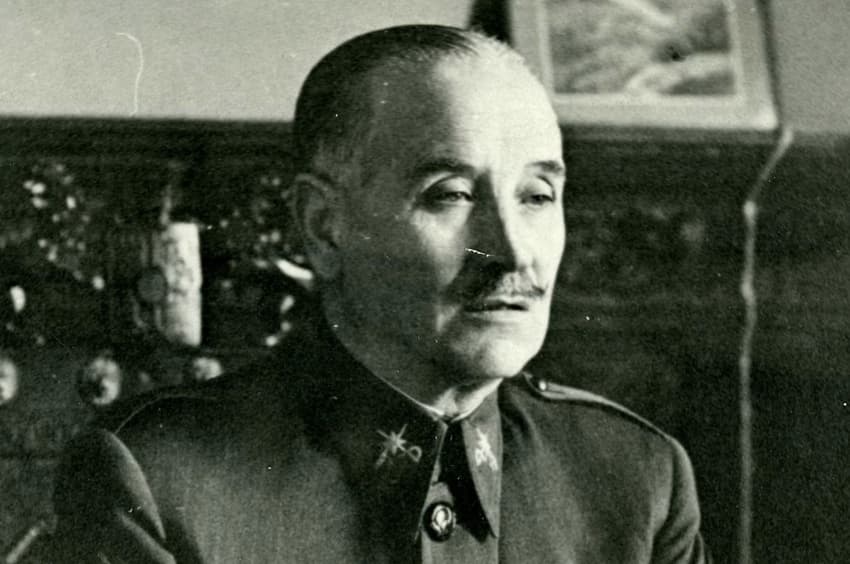Spain relocates remains of Franco ally behind death of thousands

The remains of a Francoist general who is believed to have ordered the shooting of Spain's most famous poet were relocated on Thursday from a Seville church following a new law which bans the glorification of key figures of Spain's dictatorship.
A small group of family members applauded as a van containing the remains of general Gonzalo Queipo de Llano, his wife and his right-hand man emerged from Seville's iconic Macarena basilica at 2:20 am, television images showed. Some people chanted "Viva Queipo!".
Queipo de Llano ran a military campaign in the south during Spain's 1936-39 civil war and is believed to have given the green light to the shooting of thousands of people, including celebrated Spanish poet Federico Garcia Lorca.
As his remains were being driven away from the church, Paqui Maqueda, an activist who campaigns to restore the memory of victims of the Franco regime, recited the names of family members who were executed by the rightist dictatorship.
"Honour and glory to the victims of Francoism!" she shouted.
The Macarena brotherhood, the Roman Catholic association that looks after the basilica, said the exhumations were carried out with the consent of the family members of the three people.
They were done to comply with the Democratic Memory law that came into effect last month, it added in a statement.
The law, which tackles the legacy of Franco's 1939-1975 dictatorship and the three-year civil war that preceded it, says leaders of the 1936 military coup that triggered the civil war may not remain buried in prominent public spaces other than a cemetery.
The brotherhood did not say to where Queipo de Llano's remains would be moved.
He was a member of the brotherhood and was buried in the Macarena basilica when he died in 1951.
Between 1936 and 1951, repression at the hands of Franco's forces claimed the lives of some 50,000 people in the southern region of Andalusia where Queipo de Llano operated, according to the regional government.
Spain's leftist government welcomed the exhumations.
"This is what we have to do as a democratic and civilised country," Deputy Prime Minister Yolanda Díaz told public television TVE.
But the leader of far-right party Vox, Santiago Abascal, accused the government of "profaning graves".
Socialist Prime Minister Pedro Sánchez has made the rehabilitation of the victims of the Franco era one of his priorities since coming to power in 2018.
In 2019 he had Franco's remains removed from a vast mausoleum near Madrid and transferred to a discreet family plot.
Comments
See Also
A small group of family members applauded as a van containing the remains of general Gonzalo Queipo de Llano, his wife and his right-hand man emerged from Seville's iconic Macarena basilica at 2:20 am, television images showed. Some people chanted "Viva Queipo!".
Queipo de Llano ran a military campaign in the south during Spain's 1936-39 civil war and is believed to have given the green light to the shooting of thousands of people, including celebrated Spanish poet Federico Garcia Lorca.
As his remains were being driven away from the church, Paqui Maqueda, an activist who campaigns to restore the memory of victims of the Franco regime, recited the names of family members who were executed by the rightist dictatorship.
"Honour and glory to the victims of Francoism!" she shouted.
The Macarena brotherhood, the Roman Catholic association that looks after the basilica, said the exhumations were carried out with the consent of the family members of the three people.
They were done to comply with the Democratic Memory law that came into effect last month, it added in a statement.
The law, which tackles the legacy of Franco's 1939-1975 dictatorship and the three-year civil war that preceded it, says leaders of the 1936 military coup that triggered the civil war may not remain buried in prominent public spaces other than a cemetery.
The brotherhood did not say to where Queipo de Llano's remains would be moved.
He was a member of the brotherhood and was buried in the Macarena basilica when he died in 1951.
Between 1936 and 1951, repression at the hands of Franco's forces claimed the lives of some 50,000 people in the southern region of Andalusia where Queipo de Llano operated, according to the regional government.
Spain's leftist government welcomed the exhumations.
"This is what we have to do as a democratic and civilised country," Deputy Prime Minister Yolanda Díaz told public television TVE.
But the leader of far-right party Vox, Santiago Abascal, accused the government of "profaning graves".
Socialist Prime Minister Pedro Sánchez has made the rehabilitation of the victims of the Franco era one of his priorities since coming to power in 2018.
In 2019 he had Franco's remains removed from a vast mausoleum near Madrid and transferred to a discreet family plot.
Join the conversation in our comments section below. Share your own views and experience and if you have a question or suggestion for our journalists then email us at [email protected].
Please keep comments civil, constructive and on topic – and make sure to read our terms of use before getting involved.
Please log in here to leave a comment.